Understanding Your Pallet Rack System’s Structural Limits
Pallet rack is designed to store heavy loads and maximize storage space in warehouses or other industrial settings. Systems consist of vertical upright frames connected by horizontal beams –the uprights support the beams and provide the primary structural integrity of the system. The result is a sturdy vertical storage system with multiple levels to store palletized inventory or other items.
While all that seems rather fundamental, there are significant engineering and planning decisions that must go into the rack configuration to ensure the stability and safety of the system.
Let’s take a look at three critical factors that determine pallet rack load capacity in order to understand the essentials of your system design.
Factors Impacting Pallet Rack Capacity & System Stability
While the most obvious facets of pallet rack structural integrity are the beams and uprights, the actual connector that joins those two components is also crucial to your design. Moreover, these elements work together to establish the load capacity and system stability:
- Beam Capacity
- Beam Connection
- Upright Fame Capacity & Unsupported Span
- Concrete & Connections
In addition, the frame bracing, foot plate size, and row spacing detail also play a role in the upright capacity and system integrity.
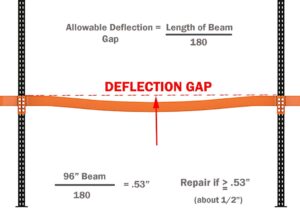 Beam Capacity
Beam Capacity
The beam capacity determines the maximum uniformly distributed load that is safely supported on the beam without excessive deflection or failure. For longer beams, deflection is the key factor driving capacity and indicates the amount of bowing a beam experiences when subjected to a load. Shorter beams can be limited by failure and/or engineering rates.
RMI (Rack Manufacture’s Institute) establishes the allowable beam deflection as the length of the beam divided by 180. For example, a 96” beam/180 allows for .53” deflection –or about ½”.
Anything above the beam deflection allowance or engineering-determined capacity is considered unsafe. Therefore, it is essential to consider the rack system’s unsupported span when selecting and installing your pallet rack beams to ensure they can adequately support the intended load and maintain structural stability.
Beam Connections
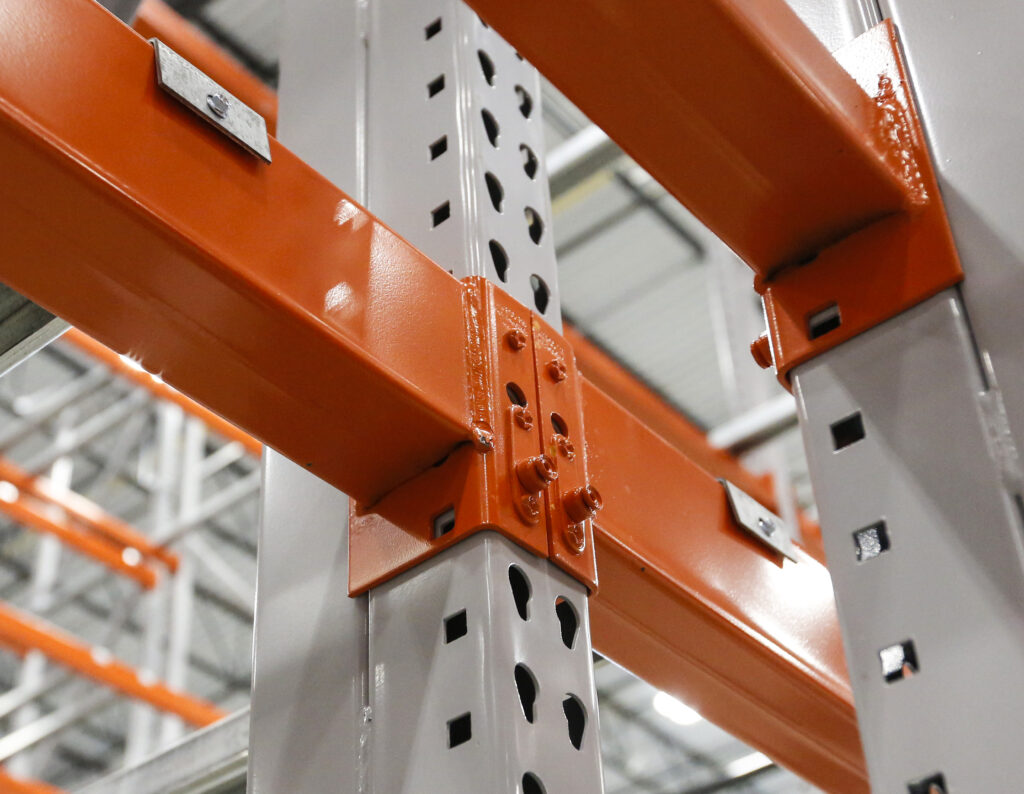
The beam and the upright frame are connected with beam connector plates, secured with pins, hooks or bolts. These connectors prevent the beam from dislodging or becoming unstable under load. The beam-to-upright connection’s integrity directly affects the system’s load capacity.
If the connection is weak or improperly installed, it can lead to a reduced load capacity and compromise the overall structural stability of the rack system. A strong and secure connection between the beam and the upright frame allows for better load distribution and transfer throughout the rack system. The requirements for the number of pins, bolts or hooks can change depending on the design, load, and seismic zone. It also helps prevent excessive deflection, sagging, or failure of the beams under heavy loads. Additionally, a properly connected beam enhances the overall rigidity and integrity of the system, ensuring it can withstand the intended load capacity without compromising safety.
Upright Frame Capacity & Unsupported Span
Upright Frame Capacity
The design of the upright frames, including their shape, dimensions, and structural features, affects their load capacity. Factors such as the profile shape (e.g., roll-formed or structural), column thickness, and bracing configurations influence the frame’s ability to withstand vertical and horizontal forces.
The height of the upright frames is also an important consideration. Taller frames generally have a lower load capacity than shorter frames due to increased susceptibility to deflection and instability. The frame height-to-depth ratio is an essential parameter to consider when assessing capacity.
The configuration of the pallet rack system, including the number of uprights, beam spacing, and additional support elements like diagonal braces or sway braces, affects the overall frame capacity.
Pallet Rack Upright & Unsupported Span
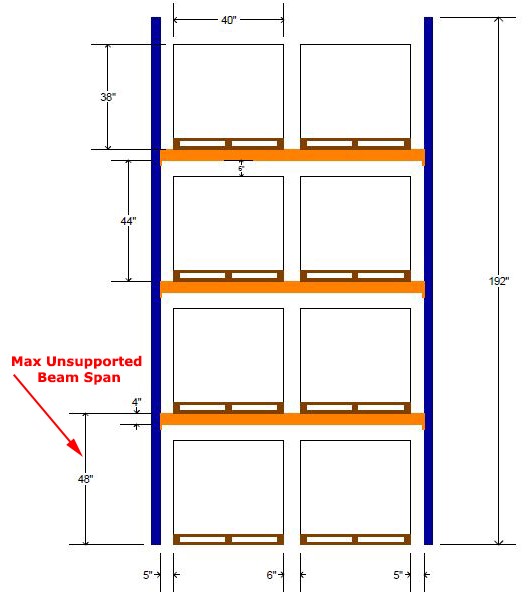 Systems are designed and engineered with specific beam spacing that creates distinct levels within the rack –the open space between beam levels within two uprights is called the unsupported span (a.k.a. vertical beam spacing). The span between the levels can be consistent within the rack height or vary, but it is critical to note that the largest opening is the value used to determine the load-bearing capacity of the system. That designation is called the maximum unsupported span.
Systems are designed and engineered with specific beam spacing that creates distinct levels within the rack –the open space between beam levels within two uprights is called the unsupported span (a.k.a. vertical beam spacing). The span between the levels can be consistent within the rack height or vary, but it is critical to note that the largest opening is the value used to determine the load-bearing capacity of the system. That designation is called the maximum unsupported span.
When designing your pallet rack system, use your specific rack manufacturer’s maximum unsupported span documentation to establish the load capacity, as it is based on the proprietary manufacturing process and design of the steel components. See below for an example.
It is important to note that as the distance between beam levels increases, the amount of unsupported space grows, resulting in a reduced capacity that the frame can support overall, i.e., the larger the space or span, the lower the capacity.
Concrete & Connections
Other elements that can affect system stability and load capacity include row spacers, pallet size, baseplate size, decking, and the presence of overhead ties. Additionally, confirm that the concrete material and slab thickness meet the 6-inch minimal requirement for anchoring. Soil subgrade must also meet the system load-bearing capacity.
What Are the Risks of An Excessive Unsupported Span?
Unsupported spans that exceed the manufacturer’s recommended limits can pose serious concerns and safety risks.
Unsupported Span Risks
- Reduced system capacity –increased risk of overload
- Increase the possibility of frame or beam deflection
- Potentially lead to component damage
- Costly rack repairs & downtime
- Structural failure –endangering personnel & damaging inventory
Pallet racking manufacturers provide capacity tables that detail load capacity based on the specific grade and thickness of the steel upright and beam components and the allowable vertical spacing. Often you can find the capacity table on your manufacturer’s website. It is essential to obtain the appropriate capacity table to evaluate and compare it with your specific rack installation requirements.

The above chart example shows how the capacity decreases for each upright as the unsupported span increases. Additionally, as you add levels, the allowable load weight per level decreases.
Bring In the Reinforcements

By maintaining the structural integrity of the rack system, you minimize the risk of a dangerous unsupported span. However, there are several corrective options to help get your system safely operational again if a concern is raised. Confirm with your system engineer to ensure the best next steps.
Correcting An Excessive Unsupported Span
- Intermediate Beams: Install additional horizontal beams between the upright frames to provide intermediate support. These beams will help distribute the load more effectively, reducing the unsupported span. Note, in some cases, you can add these beams at the rear of the system –see graphic below.
- Reinforcement Columns: Use column reinforcements (a.k.a. box columns) to provide additional vertical support. This option may involve retrofitting or modifying the existing rack system.
- System Redesign: In extreme cases, a redesign of the pallet rack system may be necessary to ensure compliance and safety. This could involve adjusting beam spacing, replacing components, or even considering a different rack configuration.
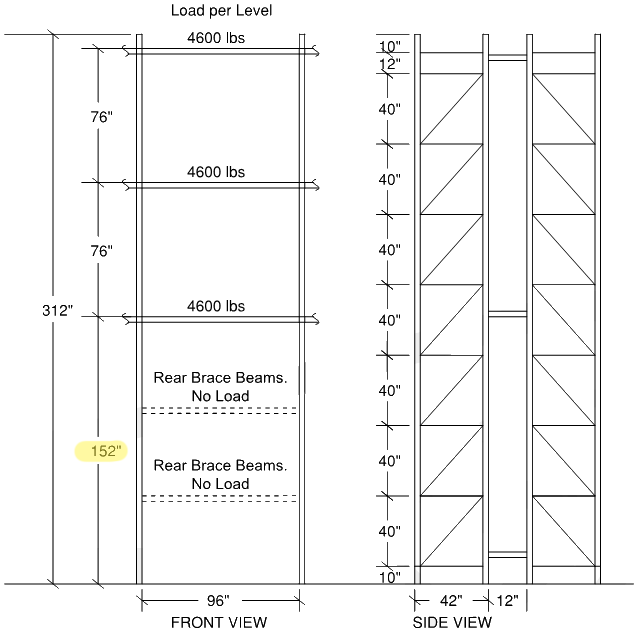 |
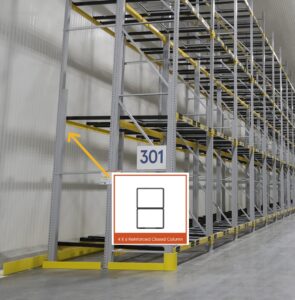 |
| Illustration (left) Shows Rear Brace Beam Option to Balance Unsupported Load (highlighted in yellow). Photo (right) Shows Reinforced Boxed Columns Option |
How Did We Get Here?
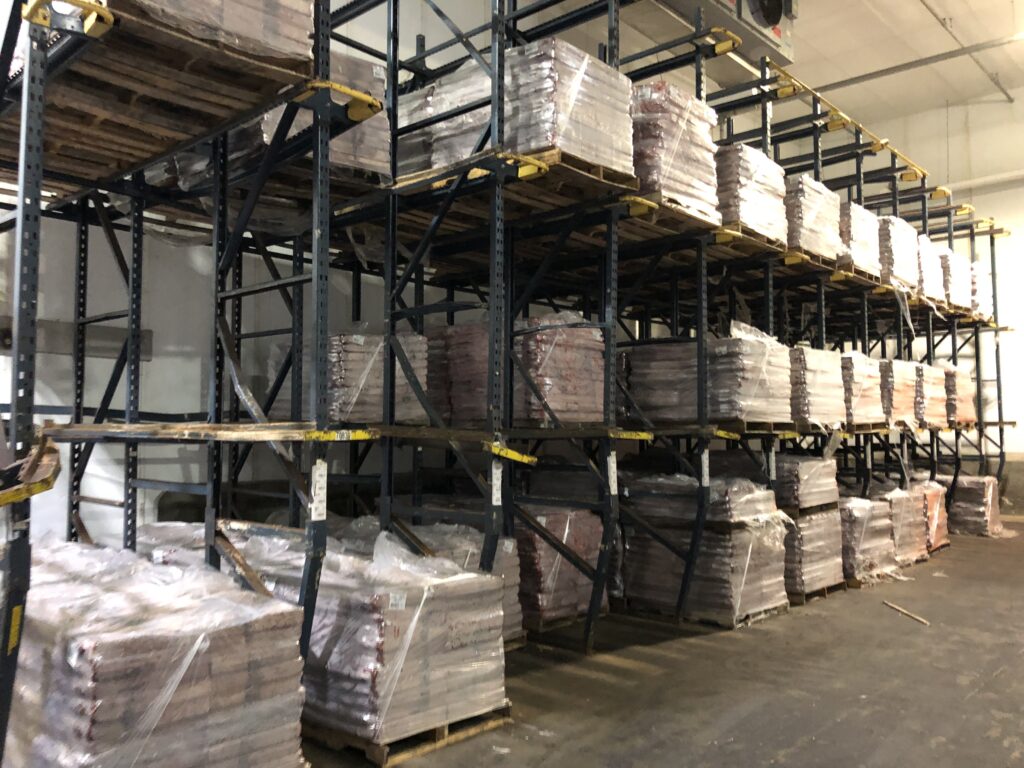
The most common cause of an excessive unsupported span in a pallet rack system is often the removal or relocation of horizontal beams to reprofile or reconfigure the rack layout. However, several fairly standard warehouse activities can lead to an unsafe, overloaded beam span.
- Reprofiling: changing inventory needs can lead to the desire to remove beams or adjust your pallet racking configuration, inadvertently creating unsupported spans. If you are considering reprofiling your pallet racking system –before you move those beams, have a licensed structural engineer review your plans vs. the original drawings to verify that the new layout meets the necessary capacity and system integrity standards. This step is vital to ensure the stability of the frame.
- Warehouse Expansion or Reconfiguration: moving your pallet racking and reinstalling it can result in unsupported spans.
- Improper Installation: accidental omission of beams during assembly can lead to unsupported spans.
- Damage or Wear: your pallet racking will likely experience damage or wear over years of use that can result in the need for component repair or replacement. If not done correctly, it can inadvertently create unsupported spans.
- Lack of Maintenance: neglecting routine inspections may allow for unnoticed damage or deterioration of components, leading to excessive unsupported spans.
![]() To prevent unsupported spans, follow the manufacturer guidelines and consult with professionals, like the Apex team when making rack modifications.
To prevent unsupported spans, follow the manufacturer guidelines and consult with professionals, like the Apex team when making rack modifications.
Also, conduct routine pallet racking inspections, including the unsupported spans, to identify any signs of damage, deflection, or instability. Promptly address any issues to maintain the system’s integrity and prevent potential hazards.
The Apex Rack Repair App can help determine if your rack pallet rack frames are stressed due to an excessive unsupported span. The app is a Free to Download tool that walks you through a pallet rack inspection –it’s the same tool our certified rack inspection team, the Apex PROs, use for their warehouse safety audits.
With the Apex Rack Repair App loaded onto your tablet or smartphone, you can gather critical specs, including photos, to upload to the Apex PROs for an expert review and assessment. You will receive a prompt reply with the next steps if needed. We also supply independent custom repair kit solutions if required.
Download our Rack Repair checklist to help ensure a thorough pallet rack inspection and review of potential warehouse safety hazards.
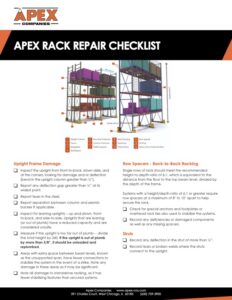 |
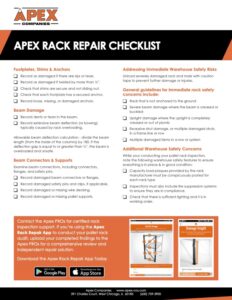 |

